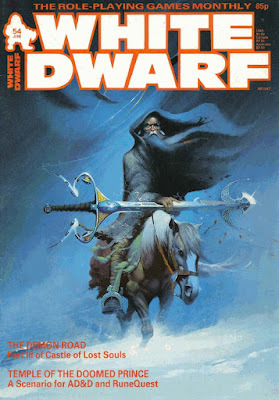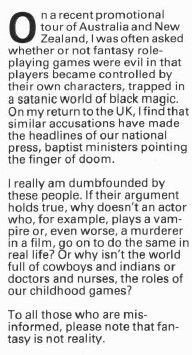White Dwarf: Issue #54
 Memory is a strange thing. Though I owned many of the issues of White Dwarf about which I've been writing in this series, some of them stand out more than others. Issue #54 (June 1984) is one of those I remember very well, in large part because of its striking cover by Peter Andrew Jones. In my opinion, the covers of Dragon were consistently good, while the covers of White Dwarf were more hit or miss. However, very few of the covers of Dragon stick in my head the way that White Dwarf's covers do. I suspect it's because the WD covers were generally wilder and more varied. They were rarely "safe" in the way that Dragon's were. That's not to say all of White Dwarf's covers were brilliant – they were not – only that many more captured my youthful imagination than did their counterparts on the front of Dragon.
Memory is a strange thing. Though I owned many of the issues of White Dwarf about which I've been writing in this series, some of them stand out more than others. Issue #54 (June 1984) is one of those I remember very well, in large part because of its striking cover by Peter Andrew Jones. In my opinion, the covers of Dragon were consistently good, while the covers of White Dwarf were more hit or miss. However, very few of the covers of Dragon stick in my head the way that White Dwarf's covers do. I suspect it's because the WD covers were generally wilder and more varied. They were rarely "safe" in the way that Dragon's were. That's not to say all of White Dwarf's covers were brilliant – they were not – only that many more captured my youthful imagination than did their counterparts on the front of Dragon.Issue #54 is also memorable for its editorial by Ian Livingstone, which touches on the issue of the Satanic Panic. I reproduce his words here in their entirety:
 Livingstone pretty well says it all, so I have nothing more to add beyond my usual bafflement that this actually happened.
Livingstone pretty well says it all, so I have nothing more to add beyond my usual bafflement that this actually happened. "Law of Nature" by Christopher Hunt is a good article on the subject of "logic in fantasy worlds." More precisely, Hunt is concerned with ensuring that fantasy settings make sense and follow intelligible rules, even though those rules may differ from "the constraints of our present world." I'm probably well disposed toward articles of this sort, because Hunt's advice is not far removed from my own general approach. In a similar vein, "Visiting Other Plains" by Ian Marsh offers advice on presenting barbarian cultures in fantasy (with an emphasis on RuneQuest) by reference to real world tribal cultures. Again, it's a good, if short, article of the sort I used to really enjoy reading.
Part 3 of Marcus L. Rowland's "The Name of the Game" focuses on science fiction RPGs, with Traveller taking pride of place, though he also references Star Frontiers, Space Opera, Star Trek, and Laserburn (which I presume had a strong presence in the UK than it did in the USA). Meanwhile, "Microview" by Russell Clark reviews two computer games, Apocalypse (6 out of 10) and Battle 1917 (7 out of 10). "Tabletop Heroes" by Joe Dever and Gary Chalk takes a look at miniature figures from Essex, Citadel, and Ral Partha with an eye toward their utility in Warhammer.
"Open Box" reviews Murder on Arcturus Station for Traveller, rating it 7 out of 10, which seems a little low to me, especially since the reviewer, like myself, enjoyed it greatly. Kharé – Cityport of Traps, the second volume of Steve Jackson's Sorcery! gets an 8 out of 10. Espionage! and the adventure Border Crossing from Hero Games receive scores of 8 and 9 respectively. Finally, there's Pursuit to Kadath, an adventure for Call of Cthulhu published by Theatre of the Mind Enterprises. The scenario is rated 8 out of 10. All in all, a good selection of products that I think give a true sense of what the hobby was like at the time in terms of its diversity.
While Dave Langford's "Critical Mass" is usually quite forgettable for me, this issue's installment is a rare example of one that I still remember to this day. First, I remember that Langford simply refused to read, let alone review, Frank Herbert's Heretics of Dune. Second, he offers a lengthy excoriation of Battlefield Earth and its author, L. Ron Hubbard. He also reviews several other books that he likes, such as Pavane by Keith Roberts, but it's his takedown of Battlefield Earth that is the main event of his column: "It's dreadful and tedious beyond endurance."
Part 3 of "The Castle of Lost Souls" solo adventure by Dave Morris and Yve Newnham is as fun as its predecessors. I really enjoyed this series of articles when it was first published. "Down Among the Dead Men" by Alex McDonald is an examination of the undead in RuneQuest. More specifically, it expands on the treatment of the undead creatures found in the RQ rulebook. The article also mentions "Games Workshop's forthcoming Questworld pack," which, sadly, never came to pass. There are new episodes of "Thrud the Barbarian," "The Travellers," and "Gobbledigook," which are as delightful as ever.
"Temple of the Doomed Prince" by Phil Holmes is the first adventure I ever encountered for Tékumel. Statted for use with Empire of the Petal Throne, AD&D, and RuneQuest, it details a ruined temple to Ksárul, the titular Doomed Prince of the Blue Room. Though its overall design is nothing special, it's filled with plenty of atmosphere and cultural oddities that piqued my interest. At the time, I'd only ever heard of Tékumel, so this whetted my appetite for more information, though it'd be several more years before I'd actually hold a copy of Empire of the Petal Throne in my hands.
"Now You See Them, Now You Don't" by Fred Lee Cain presents two new monsters for use with Dungeons & Dragons: surrogates and shapelings. Surrogates are invisible golems, while shapelings are a naturally invisible humanoid species. Despite the descriptions of each, I found the monsters themselves rather thin gruel, notable primarily for their invisibility and little else. Finally, "Goals for Role-Playing" by J. Anthony Nanson is a short piece that outlines the kinds of goals characters might pursue – risk, business, romance – and then offers for suggestions for including them in adventures. Since the article is short, I can't really fault it for its vagueness, though I can't help but feel it barely touched upon the possibilities of its premise.
As I said at the beginning of this post, issue #54 is one that I remember very vividly, even though, by objective standards, it's not one of the magazine's best. Still, the mere presence of an adventure for use with Tékumel is certainly notable, since almost no EPT scenarios were ever published in any venue, not even the pages of TSR's own Dragon. Once again, White Dwarf demonstrates its uniqueness.
 And then there was this photo from the back of the issue. Yes, it's real.
And then there was this photo from the back of the issue. Yes, it's real.
Published on October 18, 2022 07:00
No comments have been added yet.
James Maliszewski's Blog
- James Maliszewski's profile
- 3 followers
James Maliszewski isn't a Goodreads Author
(yet),
but they
do have a blog,
so here are some recent posts imported from
their feed.



